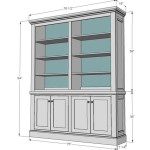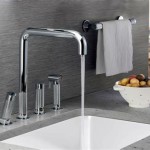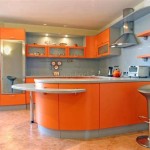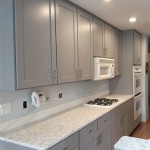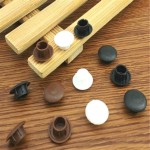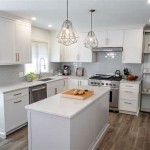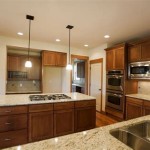What is the Standard Depth of a Kitchen Countertop?
The kitchen countertop serves as a fundamental work surface in the home, supporting a multitude of tasks from food preparation and cooking to casual dining and socializing. Its dimensions, particularly its depth, play a crucial role in usability, ergonomics, and overall kitchen design. Understanding the standard depth of a kitchen countertop is essential for homeowners, contractors, and designers aiming to create a functional and aesthetically pleasing kitchen space.
While customization is possible, a standard depth exists to provide a comfortable and efficient workspace for the average user. This standard has been developed over time, considering human reach, appliance dimensions, and common kitchen activities. Deviations from this standard can sometimes be implemented for specific design purposes, but careful consideration should be given to the potential impact on usability.
This article will delve into the standard depth of a kitchen countertop, exploring the reasons behind the measurement, variations that exist, considerations for specific situations, and the potential implications of altering this established dimension.
The Accepted Standard: 24 Inches
The most commonly accepted standard depth for kitchen countertops in the United States is 24 inches (61 centimeters). This measurement represents the distance from the front edge of the countertop to the wall behind it. This dimension is not arbitrary; it is based on a combination of factors designed to optimize functionality and comfort within the kitchen environment.
The 24-inch depth allows for sufficient space to accommodate standard-sized kitchen appliances such as dishwashers, ovens, and refrigerators. These appliances are typically designed with a depth of around 24 inches to fit seamlessly under the countertop, creating a flush and integrated appearance. Deviating significantly from this standard depth could result in appliances protruding beyond the countertop edge, disrupting the flow and aesthetics of the kitchen.
Furthermore, the 24-inch depth is ergonomically beneficial for most users. It provides adequate space for comfortable reach and maneuverability while preparing food, washing dishes, or performing other kitchen tasks. It allows for enough space to place small appliances, mixing bowls, and cutting boards without feeling cramped or restricted.
The standard depth also provides space for a backsplash, which is typically 4 inches high. The backsplash protects the wall from spills and stains and completes the look of the countertop. The combined depth of the countertop and backsplash (24 inches + 4 inches) makes the total depth from the front edge of the countertop to the top of the backsplash 28 inches.
The 24-inch depth serves as a benchmark for the industry, influencing the design and manufacturing of not only countertops but also base cabinets and appliances. This standardization simplifies the design and installation process, ensuring compatibility and a consistent aesthetic throughout the kitchen.
Variations and Exceptions to the Standard
While 24 inches is the standard depth, several situations may warrant deviations from this measurement. These variations are often driven by specific design considerations, spatial limitations, or the need to accommodate particular appliances or functionalities.
Island Countertops: Kitchen islands often feature deeper countertops than those along the perimeter of the kitchen. A common depth for an island countertop is 36 inches or even 48 inches. This increased depth provides a larger work surface and allows for seating on one side of the island, creating a functional and social hub within the kitchen.
Peninsula Countertops: Peninsulas, which are connected to a wall on one side, may also have a greater depth than the standard 24 inches, particularly if they incorporate seating. The countertop may extend beyond the base cabinets to create an overhang for comfortable legroom when seated at the peninsula.
Accessibility Considerations: For kitchens designed to be accessible for individuals with disabilities, adjustments to the countertop depth may be necessary. An increased depth can provide more space for a wheelchair to maneuver underneath the countertop, allowing for comfortable access to the sink and work area. In such cases, careful planning is crucial to ensure that all elements of the kitchen, including appliances and storage, are compatible with the altered countertop depth.
Shallow Countertops: In small kitchens or galley kitchens, space may be limited, necessitating a shallower countertop depth. A countertop depth of 20 inches or even 18 inches may be used to maximize the available floor space. However, it is important to consider the impact of a shallower countertop on usability and storage. Smaller depth can make it difficult to accommodate standard-sized appliances or provide adequate workspace for food preparation.
Custom Designs: In custom kitchens, designers may deviate from the standard depth for aesthetic or functional reasons. For example, a thicker countertop material may require a deeper countertop to accommodate the increased thickness. Or, a countertop may be designed with varying depths to create a unique visual effect or provide specific functional zones within the kitchen.
When considering variations to the standard countertop depth, it is essential to thoroughly evaluate the potential impact on usability, ergonomics, and compatibility with other kitchen elements. Careful planning and consultation with a professional kitchen designer are crucial to ensure that the altered depth enhances the overall functionality and aesthetic appeal of the kitchen.
Factors Influencing Countertop Depth Decisions
Several factors should be considered when determining the appropriate countertop depth for a kitchen. These factors include the available space, the intended use of the countertop, the style of the kitchen, and the needs of the users.
Kitchen Size and Layout: The size and layout of the kitchen are primary considerations. In small kitchens, maximizing space is paramount, and a shallower countertop depth may be necessary. In larger kitchens, a deeper countertop, particularly on islands or peninsulas, can provide additional workspace and seating.
Intended Use: The intended use of the countertop should also influence the depth decision. If the countertop will primarily be used for food preparation, a standard depth of 24 inches may be sufficient. However, if the countertop will also be used for dining, seating, or other activities, a deeper countertop may be more appropriate.
Appliance Compatibility: The depth of the countertop should be compatible with the dimensions of the appliances that will be installed beneath it. Standard-sized appliances typically require a countertop depth of 24 inches. If non-standard appliances are being used, the countertop depth may need to be adjusted accordingly.
Ergonomics: The countertop depth should be ergonomically comfortable for the users. The standard depth of 24 inches is generally suitable for most people. However, individuals with disabilities may require a deeper countertop to accommodate a wheelchair. Additionally, the height of the countertop should be considered in relation to the depth to ensure a comfortable and efficient work surface.
Aesthetic Considerations: The countertop depth should also be considered from an aesthetic perspective. A deeper countertop can create a more luxurious and spacious feel, while a shallower countertop can create a more streamlined and modern look. The countertop material, edge profile, and color should also be considered in relation to the depth to achieve the desired aesthetic effect.
Budget: Finally, the budget should be considered when determining the countertop depth. Deeper countertops typically require more material and may be more expensive to fabricate and install. It is important to balance the desired functionality and aesthetic with the available budget.
Careful consideration of these factors will help ensure that the chosen countertop depth is appropriate for the specific kitchen and meets the needs and preferences of the users.
Ultimately, selecting the optimal kitchen countertop depth is a balancing act between standardization, customization, and the practical considerations inherent in each unique kitchen space. The established 24-inch standard provides a solid foundation, but understanding the various factors that can influence this dimension allows for informed decision-making and the creation of a kitchen that is both functional and aesthetically pleasing.

A Homeowner S Guide To Kitchen Counter Height And Depth

Standard Countertops Comfortable Working Heights Widths

Standard Kitchen Counter Depth Hunker

Standard Countertops Comfortable Working Heights Widths

Standard Kitchen Countertop Height Depth Find Your Perfect Fit

Kitchen Standard Dimensions Essential Measurements
Kitchen Counter Height Slab Platform Dimensions

What Is The Standard Depth Of Countertops Lx Hausys

What Is The Standard Depth Of Countertops Lx Hausys

Standard Kitchen Countertop Height Depth Find Your Perfect Fit
Related Posts

